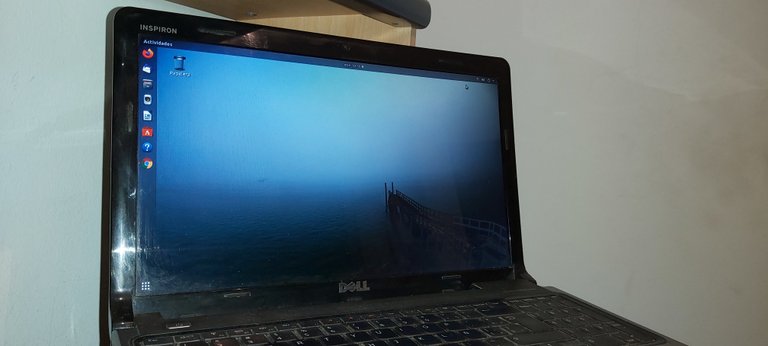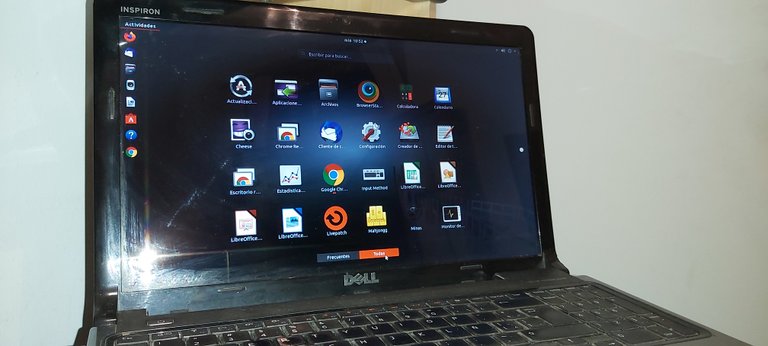How I revived an old notebook - Como reviví una vieja notebook

Reading a post from @losapuntesdetux that was published yesterday in the @hive.argentina community brought to my memory how Linux collaborated to recover a notebook that was already discarded as slow and old.
It is one of the Dell brand Inspiron models to which I have great affection, accompanied me for several years in a time of hard work and particularly difficult to get and keep customers and therefore income. At that time I worked independently and did not have an office of my own, so I went very early every morning to a local of the Havanna franchise that started as a factory of alfajores (very rich) in the city of Mar del Plata and then It converted into a chain of coffee shops that of course sold all its products, which also evolved from just alfajores to a very interesting offer of products.
Returning to the subject of my notebook, every morning I waited patiently for the store to open to go in search of a table away from the hustle and bustle that arose when, after a while, customers began to arrive in a hurry to have breakfast before starting their daily tasks in the nerve center of the City of Buenos Aires.
Generally and thanks to early hours I could access the best location, far as I said, from the hustle and bustle and the movement of people, but with an outlet that allowed me to work without using the battery, in this way I managed to make it last for all day.

Speaking of the battery, when I bought the laptop I requested an extended battery module that would allow me to use it for a long time, it was a big mistake because it was very heavy and I had to carry it all day. Also, there was always an electrical outlet somewhere to recover power.
My beloved notebook had (has) a 15 ”screen with a very good definition and at that time the operating system was Windows 7, necessary for me since the development environments I used only worked in that environment. Over the years, the laptop became increasingly slower and less of a processor. Actually I must clarify that it was not her fault, the base software was evolving, better features but also with an increasing need for more resources, both in the processing power and in the memory necessary to function in an acceptable way. I had to leave her and move on to a more powerful one.
It was left a couple of long years abandoned in a corner of my closet, I was reluctant to sell it or give it away, still less to discard it. Until I decided to test with Linux, I knew that it was an operating system that needed fewer resources and that it has reduced or "lightened" versions just to be used on PCs and laptops where resources are not abundant.
I had had some contact with similar operating systems (Unix) in the past and at that time it was not particularly friendly, only the most enthusiastic researchers used it but now everything is very different.
The experience was excellent, it starts quickly and the function that I use the most is to access my office PC through remote desktop, with this I am permanently connected and I have access to the shared disks of the organization where the projects, documents and some communication tools that when accessing them in this way I do not need to download them to the home notebook and thus relieve it of a greater load.
I chose to install Ubuntu and I find it a great operating system, many of the most used tools in Windows also have their version for Linux and you don't have to be an expert in it to install them.
It was definitely a good decision and allowed me to go back to using a PC that I already considered lost. I have another notebook, also quite old and with few resources, I will repeat the experience but I will install a lighter version. In another post, I will tell you about my new experience.
Leyendo un post de @losapuntesdetux que publicó ayer en la comunidad @hive.argentina trajo a mi memoria como el Linux colaboró para recuperar una notebook que ya tenía desechada por lenta y antigua.
Es una de la marca Dell modelo Inspiron a la que le tengo un enorme cariño, me acompañó varios años en una época de mucho trabajo y particularmente difícil para conseguir y mantener clientes y por lo tanto ingresos. Por aquellos tiempos yo trabajaba en forma independiente y no tenía una oficina propia, entonces iba todas las mañanas bien temprano a un local de la franquicia Havanna que comenzó siendo una fábrica de alfajores (muy ricos) de la ciudad de Mar del Plata y luego se reconvirtió en una cadena de cafeterías que por supuesto vendía todos sus productos, los que también evolucionaron de solo alfajores a una oferta muy interesante de productos.
Volviendo al tema de mi notebook, todas las mañana esperaba pacientemente a que abriera el local para ir en busca de una mesa alejada del bullicio que se armaba cuando un rato después comenzaban a llegar los clientes apurados por desayunar antes de iniciar sus tareas diarias en el centro neurálgico de la Ciudad de Buenos Aires.
Generalmente y gracias a hora temprana podía acceder a la mejor ubicación, lejos como dije, del bullicio y el movimiento de gente, pero con un toma corriente que me permitía trabajar sin necesidad de utilizar la batería, de esa manera lograba que la misma durara el día entero.
Hablando de la batería, cuando compré la portátil solicité un módulo de batería ampliada que me permitiera un uso prolongado, fue un gran error porque pesaba muchísimo y yo tenía que estar todo el día llevándola encima. Además, siempre había un enchufe de electricidad en algún lado para recuperar energía.
Mi querida notebook tenía (tiene) una pantalla de 15” con una muy buena definición y por aquellos tiempos el sistema operativo era Windows 7, necesario para mí ya que los entornos de desarrollo que utilizaba solo funcionaban en ese ambiente. Con los años la laptop fue haciéndose cada vez más lenta y escasa de procesador. En realidad debo aclarar que no era su culpa, el software de base fue evolucionando, mejores prestaciones pero también con una creciente necesidad de mayores recursos, tanto en el poder de procesamiento como en la memoria necesaria para funcionar en forma aceptable. Tuve que dejarla y pasar a otra más poderosa.
Estuvo un par de años largos abandonada en un rincón de mi armario, me resistía a venderla o regalarla, menos aún a desecharla. Hasta que decidí probar con Linux, sabía que era un sistema operativo que necesita menos recursos y que posee versiones reducidas o “alivianadas” justamente para ser utilizado en PC’s y laptops donde los recursos no abundan.
Yo había tenido algún contacto con sistemas operativos similares (Unix) en el pasado y aquel momento no era particularmente amigable, solo los más entusiastas investigadores lo utilizaban pero ahora todo es muy diferente.
La experiencia fue excelente, arranca rápido y la función que más uso es para acceder a la PC de mi oficina mediante escritorio remoto, con ello estoy permanentemente conectado y tengo acceso a los discos compartidos de la organización donde están los proyectos, los documentos y algunas herramientas de comunicación que al accederlas de esa manera no necesito bajarlas a la notebook de casa y de esa manera aliviarla de una mayor carga.
Elegí colocar Ubuntu y me está resultado un gran sistema operativo, muchas de las herramientas más utilizadas en Windows también tienen su versión para Linux y no hay que ser un experto en él para poder instalarlas.
Definitivamente ha sido una buena decisión y me permitió volver a utilizar una PC que ya consideraba perdida. Tengo otra notebook, también bastante antigua y escasa de recursos, repetiré la experiencia pero instalaré una versión más light. En otro post les comentaré mi nueva experiencia.
Las fotografías son de mi propiedad
The photos are my property
Héctor Gugliermo
@hosgug